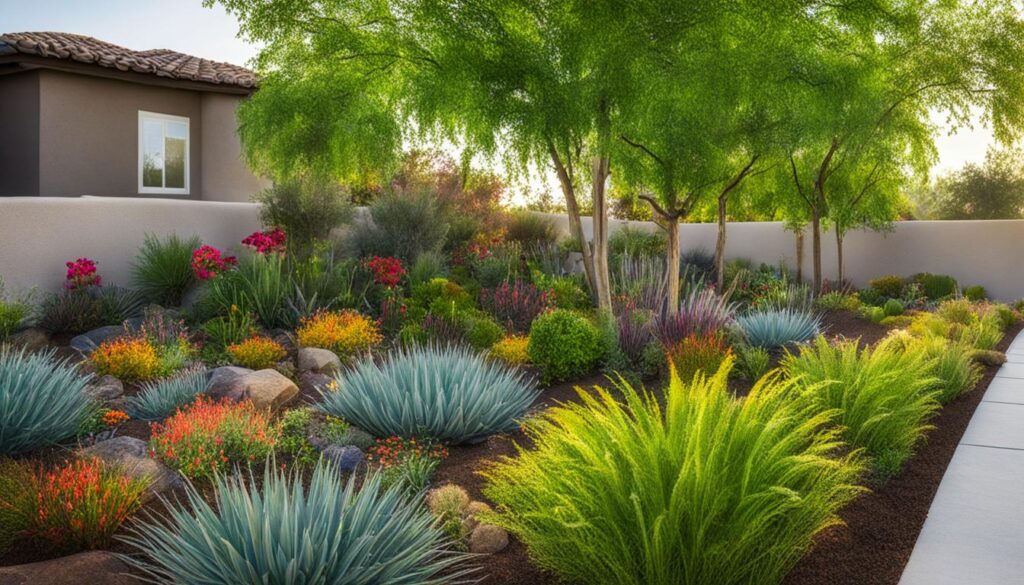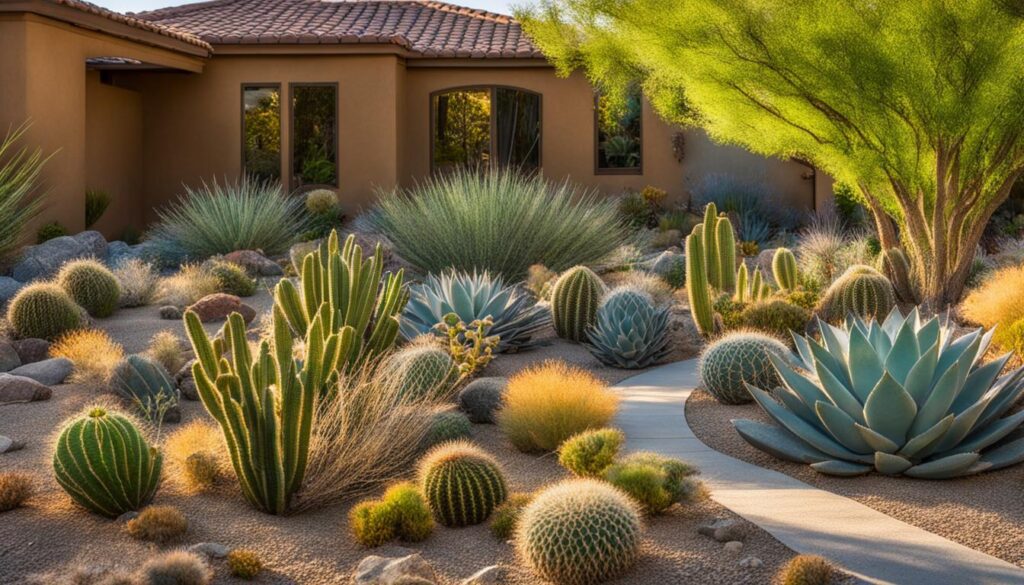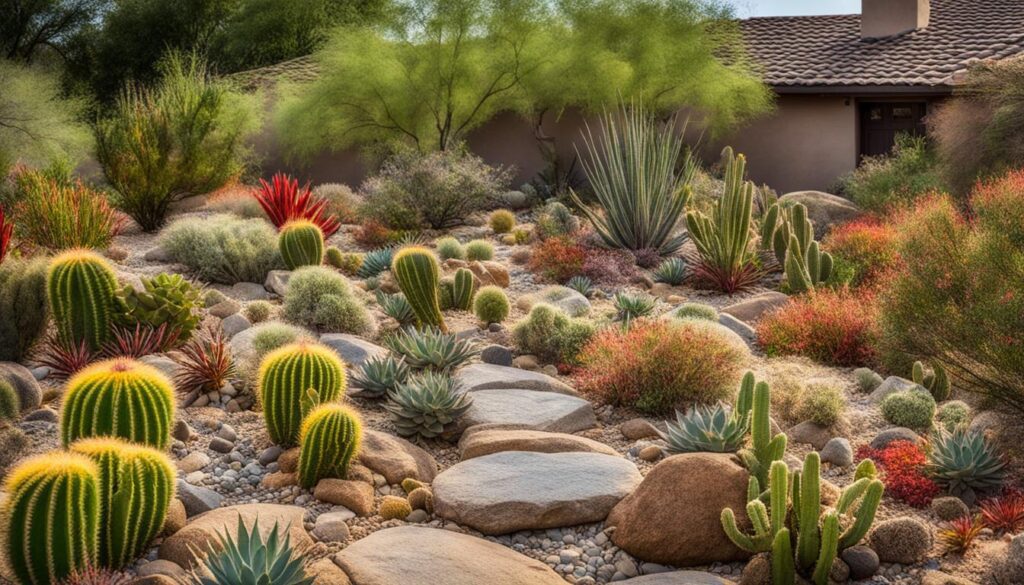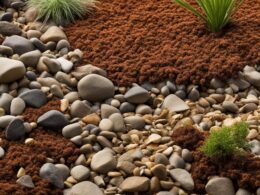Are you looking for ways to maintain a beautiful garden while conserving water during a drought? Xeriscape care is your answer. With its eco-friendly approach and emphasis on water conservation, xeriscaping has become increasingly popular, especially in dry regions of the western United States. By implementing xeriscape techniques, you can create a stunning and sustainable landscape that thrives even in drought conditions.
Key Takeaways:
- Xeriscape care is an eco-friendly approach to gardening, particularly during drought conditions.
- By choosing drought-tolerant vegetation and implementing efficient irrigation methods, you can significantly reduce water consumption.
- Xeriscaping offers environmental benefits, such as water conservation and preservation of natural habitats.
- Financial savings can be achieved through reduced water bills and lower maintenance requirements.
- Selecting the right drought-tolerant plants and designing your xeriscape garden are crucial steps in creating a successful landscape.
The Environmental and Financial Benefits of Xeriscaping
Xeriscaping offers several environmental benefits. By choosing drought-tolerant plants, you can reduce water use by as much as 75 percent, leading to significant water conservation. This not only helps combat drought conditions but also promotes sustainable water management. Xeriscaping also contributes to the preservation of the natural habitat by using native plant species. By incorporating these plants into your landscape, you can support local ecosystems and increase biodiversity.
From a financial perspective, xeriscaping can lead to substantial savings. One study conducted in Novato, California found that houses that switched from traditional lawns to xeriscaping saved an impressive 120 gallons of water per day. This translates to lower water bills and reduced expenses in the long run. Additionally, xeriscaped landscapes require less maintenance, resulting in additional cost savings. With minimal watering and reduced need for fertilizers and pesticides, you can enjoy a beautiful garden while keeping your expenses in check.
Implementing xeriscaping techniques also has a positive impact on the overall community and the environment. By reducing water consumption, you contribute to water conservation efforts, ensuring a sustainable water supply for future generations. Moreover, xeriscaping reduces the use of harmful chemicals commonly associated with traditional landscaping practices, promoting a healthier environment for both humans and wildlife.
With its environmental and financial benefits, xeriscaping is a smart and eco-friendly choice for homeowners. By embracing this approach, you can create a beautiful and sustainable landscape that enhances your outdoor space while making a positive impact on the planet.
Drought-Tolerant Plants for Xeriscaping
Xeriscaping utilizes a variety of drought-tolerant plants that thrive with minimal irrigation. These plants, known as xerophytes, have adapted to arid environments and are capable of withstanding long periods of drought. By selecting the right plants for your xeriscape garden, you can create a visually appealing and sustainable landscape that conserves water.
Cacti and succulents are popular choices for xeriscaped gardens due to their ability to store water in their leaves, stems, or roots. These plants have evolved specialized mechanisms to survive in dry conditions, such as spines or waxy coatings that help reduce water loss. Cacti, in particular, are renowned for their unique shapes and stunning blooms, adding beauty and interest to the landscape.
“Xeriscaping allows for a diverse selection of plants, providing color, texture, and even fragrance to the landscape.”
In addition to cacti and succulents, there are numerous other drought-resistant plants suitable for xeriscaping. Agave, with its striking rosette shape and spiky leaves, creates a dramatic focal point in the garden. Juniper, a low-maintenance evergreen shrub, offers year-round beauty with its blue-green foliage. Lavender, known for its fragrant flowers and aromatic leaves, adds a touch of elegance to any xeriscape garden. Various herbs and spices, such as rosemary, thyme, and oregano, not only provide culinary delights but also thrive with minimal watering.
Furthermore, some food plants naturally possess drought-resistant qualities, making them ideal for xeriscaping. Black walnuts, known for their rich flavor and valuable timber, tolerate dry conditions and provide shade with their large canopies. Jerusalem artichokes, a type of sunflower, produce edible tubers and vibrant yellow flowers while requiring little water. Incorporating these food plants into your xeriscape garden not only adds functionality but also contributes to sustainable living.
Creating a Beautiful and Resilient Landscape
Xeriscaping allows for a diverse selection of plants, providing color, texture, and even fragrance to the landscape. By combining different species and incorporating hardscape elements, such as rocks, gravel, and mulch, you can create visually appealing and low-maintenance designs.
- Consider the climate and microclimate of your region: Choose plants that are well-suited for the specific conditions of your area. Native plants are often the best choice as they have adapted to the local climate and require less water and maintenance.
- Group plants based on water needs: By grouping plants with similar water requirements together, you can create efficient watering zones. This helps ensure that each plant receives the appropriate amount of water without over-watering any particular area.
- Create layers and focal points: Use plants of varying heights and textures to create visual interest and depth in your xeriscape garden. Incorporate focal points, such as ornamental grasses or flowering shrubs, to draw attention and add visual impact.
- Add mulch and ground covers: Mulching around plants helps retain moisture in the soil, reduces weed growth, and improves overall plant health. Choose organic mulches, such as wood chips or straw, to further conserve water by minimizing evaporation.
With careful plant selection and thoughtful design, you can create a beautiful xeriscape garden that thrives in drought conditions while minimizing water usage and maintenance requirements.
Efficient Irrigation Methods for Xeriscaping
Xeriscaping is not just about choosing the right plants and designing a beautiful landscape; it also involves implementing efficient irrigation methods to conserve water. By employing these techniques, you can minimize water waste and ensure that your xeriscaped garden thrives while using minimal irrigation.
Drip Irrigation
Drip irrigation is a highly efficient method that delivers water directly to the base of the plants, reducing evaporation and minimizing runoff. This system uses a network of tubes and emitters to distribute water slowly and evenly, ensuring that each plant receives the necessary moisture. By targeting the root zone, drip irrigation helps plants establish strong root systems, resulting in healthier and more drought-tolerant vegetation. This method can reduce water usage by up to 50% compared to traditional sprinkler systems.
Soaker Hoses
Soaker hoses are another effective irrigation option for xeriscaped gardens. These porous hoses release water gradually along their entire length, allowing it to soak directly into the soil. By placing the hoses strategically around your plants, you can ensure that the water reaches the roots where it is needed most. Soaker hoses not only conserve water but also help prevent water runoff and minimize weed growth by delivering water only to the targeted areas.
Grouping Plants with Similar Water Needs
One of the key principles of efficient xeriscaping is grouping plants with similar water requirements together. This practice allows you to create specific irrigation zones within your garden, ensuring that plants with higher water needs receive adequate hydration while avoiding overwatering plants that are more drought-tolerant. By implementing this approach, you can optimize water usage and reduce the overall demand for irrigation.
Maintaining a Xeriscaped Landscape
Proper maintenance is essential for the long-term success of your xeriscaped landscape. By following a few key practices, you can ensure that your eco-friendly garden thrives and remains low-maintenance.
Weed Control
Weeds can quickly take over a xeriscaped garden if not properly managed. Regular weeding is necessary to prevent weeds from competing with your drought-tolerant plants for nutrients and water. Apply a layer of organic mulch, such as wood chips or bark, around your plants to inhibit weed growth and conserve moisture in the soil.
Pruning
To maintain the health and appearance of your xeriscaped plants, regular pruning is essential. Prune back any dead or damaged branches to promote new growth and maintain the desired shape of your plants. Additionally, removing any diseased or insect-infested foliage will help prevent the spread of pests and diseases throughout your garden.
Soil Health
The quality of the soil in your xeriscaped landscape plays a crucial role in the overall health and success of your plants. It’s important to periodically test the soil to ensure it has the proper pH balance and nutrient levels. If necessary, amend the soil with organic matter, such as compost or well-rotted manure, to improve its texture and fertility. Regularly monitor soil moisture levels and adjust your watering schedule accordingly to prevent over- or under-watering.
By implementing these maintenance practices, you can enjoy a vibrant and thriving xeriscaped landscape that requires minimal effort to maintain. With proper weed control, pruning, and soil health management, your eco-friendly garden will continue to be a beautiful and sustainable addition to your home.
Planning and Designing a Xeriscape Garden
When it comes to planning and designing a xeriscape garden, a thorough site analysis is essential. By assessing the unique features of your yard, you can create a well-designed and efficient landscape that conserves water and enhances its aesthetic appeal. Begin by evaluating the land slope, sunlight patterns, shade zones, and areas prone to dryness or wetness. This analysis will help you determine the best layout and placement for your plants, ensuring they receive the appropriate amount of water and sunlight.
One important aspect of xeriscape planning is choosing the right plants based on their water, light, and soil requirements. By selecting native plants that are naturally adapted to the local climate, you can minimize the need for irrigation and create a sustainable ecosystem. Divide your yard into zones based on the water needs of different plant species. This zoning approach allows for more efficient watering, as plants with similar water requirements can be grouped together.
Designing a xeriscape garden also involves considering the intended use of the space. Whether you plan to create specific areas for gardening, relaxation, or pet activities, it’s important to incorporate these elements into your design. By carefully planning the layout, you can ensure that your xeriscape garden meets your functional needs while still providing water-efficient and visually appealing features.
Conclusion
By embracing xeriscape care during drought, you can make a significant contribution to water conservation while enjoying the benefits of low-maintenance landscaping. Xeriscaping offers an effective solution for creating beautiful and sustainable landscapes in water-scarce regions. With the use of drought-tolerant plants, efficient irrigation methods, and proper maintenance techniques, you can reduce water consumption and create a visually appealing outdoor space.
Not only does xeriscaping promote water conservation, but it also enhances biodiversity by utilizing native plant species. These plants are well-adapted to the local climate, requiring less water and maintenance compared to traditional landscaping methods. By incorporating xeriscape principles into your garden design, you can create a habitat that attracts local wildlife, while minimizing the need for excessive watering and fertilizing.
One of the key advantages of xeriscaping is its low-maintenance nature. With careful plant selection and proper soil preparation, your xeriscape garden can thrive with minimal ongoing maintenance. By mulching to retain moisture and suppress weed growth, and implementing regular weeding and pruning, you can ensure the health and longevity of your xeriscaped landscape without the need for excessive time and effort.
In conclusion, xeriscaping is not only an effective approach to landscaping during drought conditions but also a sustainable and eco-friendly choice. By conserving water, enhancing biodiversity, and reducing maintenance, xeriscape gardens offer a practical and visually appealing solution for homeowners looking to create beautiful outdoor spaces that are in harmony with the environment.













